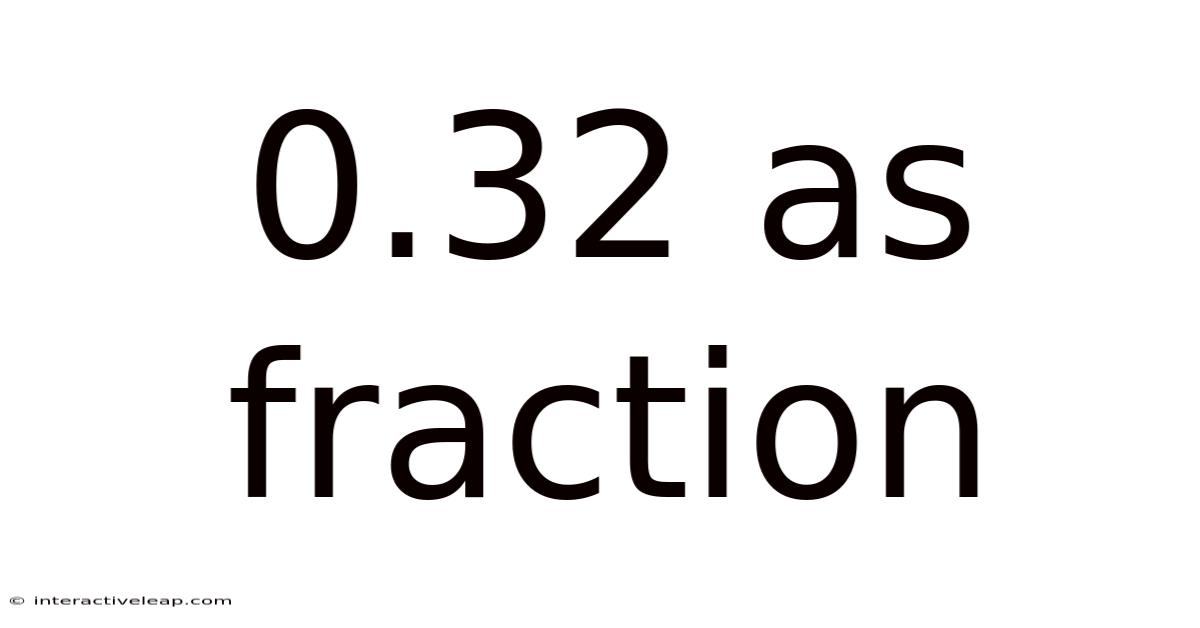0.32 As Fraction
interactiveleap
Sep 17, 2025 · 5 min read

Table of Contents
Decoding 0.32: A Comprehensive Guide to Converting Decimals to Fractions
Understanding how to convert decimals to fractions is a fundamental skill in mathematics. This comprehensive guide will delve into the process of converting the decimal 0.32 into a fraction, explaining the steps involved and providing a deeper understanding of the underlying concepts. We'll explore different methods, address common questions, and ultimately empower you to tackle similar decimal-to-fraction conversions with confidence. This guide is perfect for students, educators, and anyone seeking to improve their mathematical understanding.
Understanding Decimal and Fraction Representation
Before we dive into the conversion process, let's clarify the meaning of decimals and fractions. A decimal is a way of representing a number using a base-ten system, where the digits to the right of the decimal point represent fractions with denominators that are powers of 10 (10, 100, 1000, and so on). A fraction, on the other hand, represents a part of a whole, expressed as a ratio of two numbers – the numerator (top number) and the denominator (bottom number).
The decimal 0.32 represents 32 hundredths, meaning 32 parts out of 100. Our goal is to express this same value as a fraction.
Method 1: Direct Conversion Using Place Value
The easiest way to convert 0.32 into a fraction is by directly using its place value. The number 0.32 can be read as "thirty-two hundredths". This directly translates to the fraction:
32/100
This fraction is already in a valid form, but we can simplify it further.
Simplifying Fractions: Finding the Greatest Common Divisor (GCD)
Simplifying a fraction means reducing it to its lowest terms. To do this, we need to find the greatest common divisor (GCD) of the numerator (32) and the denominator (100). The GCD is the largest number that divides both the numerator and the denominator without leaving a remainder.
Several methods exist to find the GCD. Let's use the prime factorization method:
- Prime factorization of 32: 2 x 2 x 2 x 2 x 2 = 2<sup>5</sup>
- Prime factorization of 100: 2 x 2 x 5 x 5 = 2<sup>2</sup> x 5<sup>2</sup>
The common prime factors are two 2s (2<sup>2</sup>). Therefore, the GCD of 32 and 100 is 4.
Now, we divide both the numerator and the denominator by the GCD:
32 ÷ 4 = 8 100 ÷ 4 = 25
This gives us the simplified fraction:
8/25
Therefore, 0.32 is equivalent to the fraction 8/25.
Method 2: Using the Power of 10
Another approach involves understanding that 0.32 is 32 divided by 100. This gives us the fraction:
32/100
From here, we follow the same simplification process as described in Method 1, dividing both the numerator and the denominator by their GCD (4), to arrive at the simplified fraction:
8/25
Method 3: Long Division (Less Efficient for this case)
While less efficient for this specific example, long division can be used to convert a decimal to a fraction. This method is more useful for repeating decimals. You would divide the numerator (32) by the denominator (100), which would give you 0.32, confirming our initial conversion. This method is not recommended for simple decimal-to-fraction conversions.
Expanding the Understanding: Working with More Complex Decimals
The principles discussed above can be applied to more complex decimal numbers. Let's consider the decimal 0.625:
- Identify the place value: 0.625 represents six hundred twenty-five thousandths.
- Express as a fraction: This translates to 625/1000.
- Simplify the fraction: Find the GCD of 625 and 1000. Through prime factorization or other methods, you'll find the GCD is 125.
- Divide both numerator and denominator by the GCD: 625 ÷ 125 = 5 and 1000 ÷ 125 = 8.
- Simplified fraction: The simplified fraction is 5/8.
Therefore, 0.625 is equivalent to 5/8.
Addressing Common Questions and Misconceptions
Q: Why is simplifying fractions important?
A: Simplifying fractions ensures that the fraction is expressed in its most concise and easily understood form. It is mathematically equivalent to the unsimplified fraction but is more manageable for calculations and comparisons.
Q: What if the decimal has repeating digits?
A: Converting repeating decimals to fractions requires a different approach, often involving algebraic manipulation. For example, converting 0.333... (repeating 3) to a fraction involves setting x = 0.333... and then multiplying by 10 to get 10x = 3.333... Subtracting x from 10x gives 9x = 3, leading to x = 1/3.
Q: Can all decimals be converted to fractions?
A: Yes, all terminating (ending) decimals can be expressed as fractions. Repeating decimals can also be converted into fractions, but the process is different and involves algebraic techniques.
Conclusion: Mastering Decimal-to-Fraction Conversion
Converting decimals to fractions is a crucial skill in mathematics. By understanding place value and the process of simplifying fractions, you can effectively convert any terminating decimal into its equivalent fractional representation. Remember to always simplify your fraction to its lowest terms for a clear and concise result. Practicing with different examples will solidify your understanding and build your confidence in tackling more complex mathematical problems. This process not only improves your mathematical skills but also strengthens your problem-solving abilities in general. Through consistent practice and a thorough grasp of the underlying principles, you'll master this fundamental skill and confidently navigate the world of numbers.
Latest Posts
Latest Posts
-
275mm In Inches
Sep 17, 2025
-
Width Gymnastics Beam
Sep 17, 2025
-
77 X 2
Sep 17, 2025
-
1 5 Scale
Sep 17, 2025
-
220c To F
Sep 17, 2025
Related Post
Thank you for visiting our website which covers about 0.32 As Fraction . We hope the information provided has been useful to you. Feel free to contact us if you have any questions or need further assistance. See you next time and don't miss to bookmark.